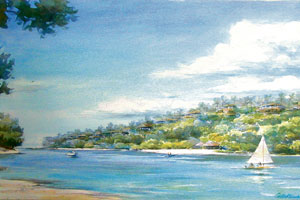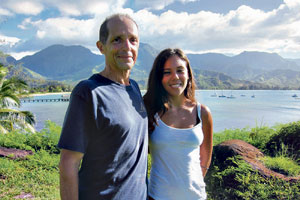Pros And Cons Of Developing Hanalei
Pierre Omidyar’s plan to build a resort on the ridge overlooking Black Pot Beach Park is in the works
“It is our kuleana to be the proper stewards of this land,” says Michelle Swartman as she strolls barefoot through the grass on the ridge overlooking Black Pot Beach Park, where Hanalei Plantation Resort will be built in the coming years. “This is my backyard, too,” adds the North Shore resident, who serves as the director of Land and Community Development for Ohana Real Estate Investors, a land asset management and development team for eBay founder and Punahou School graduate Pierre Omidyar.
The 63-acre parcel of land Swartman speaks of was purchased by Omidyar in 2007, and the $150 million resort-zoned project is currently in the permitting and entitlement stages, as well as a community-outreach phase.
The resort is projected to house 86 hotel bungalows and 34 single-family homes approved to operate as transient vacation units. Groundbreaking could happen within the next two to three years.
The project has plans to restore and revitalize a 600-year-old fishpond, which has a wall approximately 10 feet wide, 15 feet deep and 1,000 linear feet across. The fishpond, currently a swamp, has been dormant for many years and is overgrown with weeds, silt and sediment.
“This fish pond has such a long history and has so many stories to tell, and it’s such a large part of the story of Hanalei that it’s sad that there is no one before us to have restored it,” says Swartman as she continues the tour of the property she represents, pointing out the neglected area teeming with mosquitoes and 6to 8-foot-tall weeds rising from accumulated mud and debris. “It’s somewhat sad to see it in the condition it’s in right now because it’s not a healthy ecosystem.”
Swartman is determined to keep the project as environmentally, culturally and economically sound as possible.
“It is our duty to make sure that this project is done right, and restoring this ancient fishpond is one of the many goals we wish to accomplish,” she says.

Rendering of what the project will look like from Black Pot Beach Park, according to the developer. Artist rendering by Carter Black, Design by WCIT Architecture
However, the 25 homes slated to sit on the edge of the ridge have some community members upset.
“Perpetuating the exclusivity of these multi-million-dollar homes overlooking the bay where so many people come to embrace the beauty is just one more thing that takes away from the beauty of Hanalei,” says Hayley Ham Young-Giorgio of Hanalei Bay Coalition, a group of activists against the development.
“We really appreciate the natural beauty this place has,” says Ham Young-Giorgio, who resides on the North Shore. “So trying to preserve that is really where my heart speaks from.”
The Kaua‘i native of Hawaiian heritage says Hanalei is her home. Her great-grandfather used to fish in the bay and cook out of a big, black pot for the community, thus the origination of the location’s name of Black Pot.
“I still have the pot somewhere,” she says.
According to Ham Young-Giorgio, the area continues to be a place where families and friends gather, and the homes that are projected to be built on the edge of the ridge are offensive.
“There’s something about this place that deserves to be protected,” agrees Hanalei Bay Coalition member Carl Imperato. “We’re not saying don’t build, we’re just saying build it somewhere else. There is no way to build anything on this ridge without changing the heart and soul of Hanalei.”
Plans to mitigate view plane concerns have already been acknowledged. The 25 residences dotting the hillside (the exact square footage for each is still undetermined) will have restrictions such as height limits of 25 feet from the ground as well as design guidelines. In addition, further mitigation efforts have been taken including density limits, as the entire project site is actually approved for more than 200 units but will only hold a total of 120.
Furthermore, the resort-zoned site has accommodated visitors in the past with resorts such as Club Med. In fact, concrete structures remain from a project that was supposed to include 204 hotel units but never became fully operational.
“What people see today, they actually think they’re looking at virgin land,” says Swartman.
On the other hand, when those hotels were operating, Hanalei wasn’t really developed.
“If you put it into perspective, nothing else was around,” says Ham Young-Giorgio.
But just as Club Med provided jobs for people in the past, Hanalei Plantation Resort will do the same.
“They’re not thinking about their children,” says Barbara Say of the Kaua‘i/Ni‘ihau Island Burial Council and member of the development’s steering committee, regarding those opposed to the project.
The resort will provide jobs locally during its construction all the way through to its day-to-day operations.
“I saw the plans, and it looks nice,” adds Say, a Hawaiian native who currently lives in Wailua but has called Hanalei her home for some 40 years. “They are being very respectful, and it isn’t going to destroy the view plane.”
The property also will continue to provide public access to the beach with the intention of adding a second route that will venture by the fishpond and the restored native environment.
Still, with all of these ideas on the horizon, the project is still very much in its planning stages. Swartman is working with a team that includes hydrologists, biologists, archaeologists and other experts within the environmental and cultural fields.
“The answers aren’t all there yet, but we have a lot of smart people to help us understand and share them as they come,” she says. “We do believe that this resort could be an example of doing things pono.
“We are a landowner and we are a neighbor, and we have a lot of skin in the game. We are one of them; we are one of the community and we are not going anywhere.”
For more information about the project, visit hanaleiplantation.com. For more information on Hanalei Bay Coalition, visit signon.org/sign/stop-the-development.





